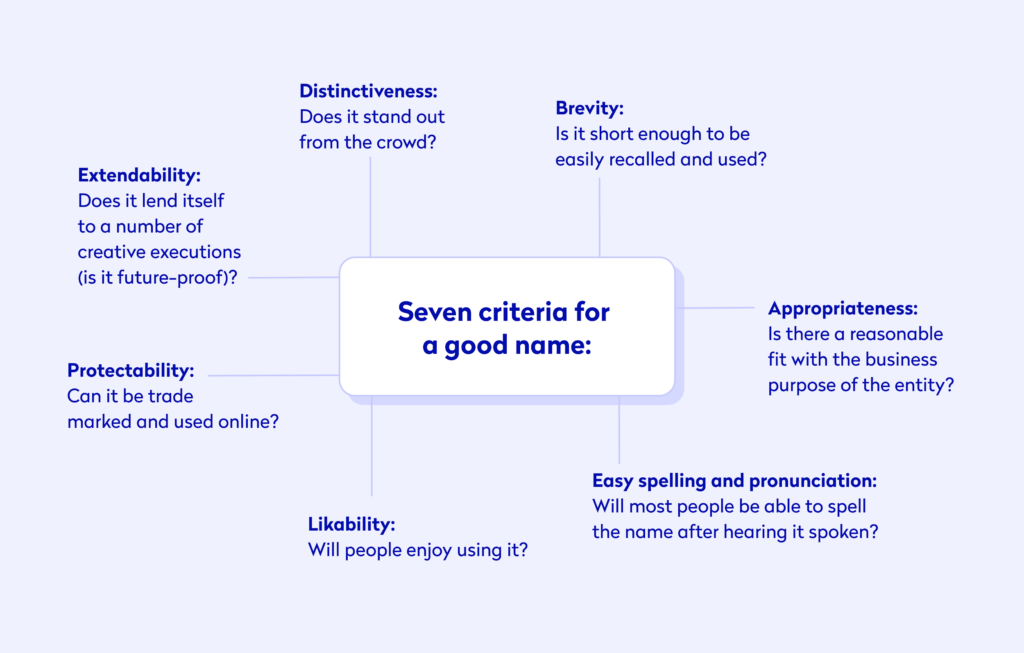
How to come up with a business name

Backed by good branding and a comprehensive go-to-market strategy, a business name can become the most memorable and recognisable part of your venture. But deciding on how to name a business can be tricky.
In this post, we’re going to look at what makes a good business name, how to come up with a business name, and what you need to do to make it official.
Table of contents
- What makes a good business name?
- Step 1: Define your business
- Step 2: Brainstorm ideas
- Step 3: Check availability
- Step 4: Register your company name
What makes a good business name?
Your business name is critical to your company’s identity – it’s what will help differentiate your business in your target market. While it takes good products, services, marketing and experiences to give a name long-lasting value, the word or words you choose can create an immediate, if often subconscious, impression. Therefore, knowing how to name your business is incredibly important.
To start, your name should meet the seven criteria for a good name, first introduced by branding expert Marty Neumeier in his book, The Brand Gap, back in 2005.

Keep this list close to hand when you begin brainstorming possible name ideas.
The seven types of brand names
According to Want Branding CEO, Jonathan Bell, whose company has worked on brand naming for Google, Disney, Intel and Gillette among others, there are seven types of business names, which means your name will fall into one of the following seven categories:
- Eponymous – Based on the name of the company founder (i.e. Gregg’s or Ford).
- Descriptive – Based on what the company does and/or their location (i.e. British Airways or Pizza Hut).
- Acronymic – Using Letters in place of words (i.e. ASOS or H&M).
- Suggestive – Using words that suggest what the company does (i.e. Netflix or eBay).
- Associative – Using words that have positive associations (i.e. Amazon or Pampers).
- Non-English – Based on words in a foreign language (i.e. LEGO or Patagonia).
- Abstract – Based on catchy made-up words or the combination of two or more words to create a new word (i.e. Swatch (a constriction of ‘second watch’) or Kodak).
This list should throw up a few name ideas. Use it alongside the seven criteria when coming up with brand name ideas.
Once you know what makes a good company name, the naming process is relatively straightforward. We’ve broken it down into four steps.
Step 1: Define your business
For your business name to have long term appeal, it needs to fit with your company values, mission, objectives and audience. Before you begin brainstorming business name ideas, have a clear view of:
- Why your business exists (what you stand for)
- Your products and services
- The competition
- Your target audience
- Your long-term plans
If you have a business plan, you’ll find all the answers you need there. If not, spend a bit of time getting the fundamentals down on paper.
Top Tip: If you need help, read our guide on how to create a business plan ⚡️
Step 2: Brainstorm ideas
There’s no such thing as a bad idea at this stage, so any word or phrase, however obscure or silly it may sound at first, is worth getting down on paper.
Idea generation thrives in collaboration too, so if you can, get several members of your team around a table.
Aim for clever and quirky names for your business. These can be made-up words, random words from a dictionary or favourite novel, acronyms, misspelt words or combinations of words. Think along the lines of those businesses with abstract and associative names.
A lot of great business names come from seemingly meaningless words. For example, Häagen-Dazs is a name that conveys tradition and craftsmanship, but it’s completely made up.
Use a name generator like Shopify’s business name generator or BrandBucket.
If you’re struggling to come up with ideas for names to add to your list, try entering words into any of the following resources to see what comes up:
Gather some potential ideas and then consider what each business name tells your audience:
- Does the name create the right first impression?
- Does it paint a picture in the mind of the reader that links to your product or service?
- Does it fit with your business mission and values?
- Does it sound good when said aloud?
- Will it still be relevant in 5-10 years when your business has grown and evolved?
Once you’ve shortlisted a list of names, it’s time to make sure that the business names are available.
Step 3: Check availability
With 5.6 million private sector businesses in the UK alone, there are no guarantees that the name you have in mind is available to use for your business, which is why we recommend having more than one name you’d be happy to run with.
Use our free Company Name checker to check multiple names at once to see if they’re available.
Before finalising your name, check to see that no other business is using it by searching:
- Registered trademarks
- Domain name availability
Search Google
Searching Google for your business name and intended URL is the quickest way to see if a company with the same name exists. It will also show results for businesses with similar names so that you can avoid potential clashes or legal issues.
Searching registered trademarks
If another company has trademarked the name that you’re using, you risk legal action against your business, which could force you to change to a different name and rebrand your entire business.
For example, in 2019 Bentley Motors lost a trademark battle with clothing company Bentley Clothing over the use of the Bentley name, meaning the car manufacturer’s range of bags, hats, purses and wallets can no longer feature its brand name.
You can easily check if a similar trademark to your business name already exists by entering your name into Gov.uk’s trade mark search tool.
If your name is available to trademark, you’re able to register it for use in the UK. A registered trademark is valid for 10 years and needs to be renewed after that period is up.
You’ll also need to actively use the trademark to avoid losing it, so don’t register a name unless you plan to use it. Also, if you plan on doing business internationally, you may have to register for international trademark protection to avoid potential conflict abroad.
Top Tip: Trademarking your name falls into the category of intellectual property. Other types of intellectual property are copyright, patents, trade secrets and designs. You should familiarise yourself with everything that you may need to register to protect to ensure nobody steals or copies your business name or ideas. To learn more, read our guide on how to protect a business idea and secure your intellectual property 🔐
Searching domain availability
If you plan on running or promoting your business online, you’ll need to check that the domain for your business name is available. You can do this by searching the database of a domain registrar like GoDaddy or 123Reg.
Step 4: Register your company name
Once you’ve settled on a name (or two), you can make it official by registering your business with Tide.
The rules around registering your name depend on whether you’re setting up as a sole trader or partnership, or a limited company.
- Sole traders and partnerships aren’t required to register their business name but can use it to trade under.
- Limited companies do have to register their name.
Your company name does not have to be the same as your trading name, and many businesses will have several trading names all under one company name.
The government also has its own rules on naming that may impact your chosen name. If your name meets the seven criteria and you’ve carried out your checks on availability, there’s a good chance your name can be registered.
Not every business name that’s registered is trademarked and not every business has an online presence, so you should be aware of the rules. Companies House states that business names should avoid:
- ‘Same as’ names (as mentioned above) where the only difference to an existing name is certain punctuation, certain special characters (i.e. the ‘plus’ sign), a word or character that’s similar in appearance or meaning to another from an existing name, or a word or character commonly used in UK company names.
- ‘Too like’ names where the name is too similar to another that already exists. To use Companies House’s example, ‘Easy Electrics For You Ltd’ is the same as ‘EZ Electrix 4U Ltd’.
- Names with sensitive words or expressions, or words that suggest a connection with government or local authorities, unless you have permission.
- Trading names with the words ‘limited’, ‘Ltd’, ‘limited liability partnership’, ‘LLP’, ‘public limited company’, or ‘plc’.
Companies House will contact you if your name is already in use or in breach of the rules and provide instructions on what to do.
As registering your business name is done in tandem with registering your company with HMRC and Companies House, you’ll need to think about your company structure and how you plan to trade.
Top Tip: To help you understand structures, the registration process and the costs involved, take a look at our guide on how to register a business in the UK ✅
Wrapping up
Coming up with a business name is a creative process, and as with any creative pursuit, striking gold can take hours, days, or even weeks. Take as much time as you need. If you’re not satisfied with the first round of brainstorming, repeat the process.
Use the tools, tips and resources we’ve included in this post and seek creative input from other members of your team, or people in your social circles if you’re working alone, to come up with names you’re truly happy with. Then follow the steps to make that name official.
If you choose to proceed with the limited company structure, register your business with Tide for £9.99. You’ll also get a free business bank account so you can manage your business finances more efficiently.
Photo by You X Ventures, published on Unsplash






